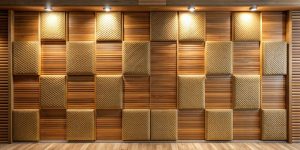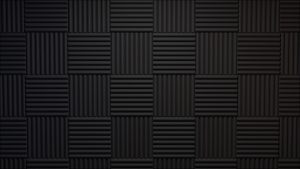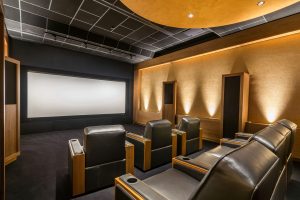Golf simulator buying guide
Summer is back, and to millions of people around the world, that means one thing: golf. When the weather gets great, the golfers get going. It’s a nice, relaxing stroll in the park that people get crazy competitive over. When we aren’t shooting well, we blame our clubs and our stiff muscles and want to know who the people driving 300 yards are. Well, they may be the people that buy golf simulators.
Why buy golf simulators?
People who own residential golf simulators are able to practice 365 days a year. It doesn’t matter if it’s midnight in a thunderstorm. You can bang out a quick round whenever you want. With all that extra practice, your game is sure to improve. If this is the year you plan to make significant strides in your game, maybe home virtual golf is for you.
How does virtual golf work?
Virtual golf is a simple concept played with sophisticated machinery. Basically, you turn a portion of your home into an indoor driving range, and the golf simulator measures and tracks your shots to deliver real-time video gameplay.
When you take your shot, the simulator imagines your shots past the net and into the world of virtual golf courses from around the world. The sophisticated software can read nearly everything about your shot. Gathering all that info on your strike power, angle, and follow-through means your shots follow a very realistic track. This gives you the ability to understand where your mechanics are off and make the changes necessary to improve your game.
You can play a round by yourself on your lunch break, or you can have the crew over for a Saturday tour of all the courses you’ve been dying to play together. Sound fun?
What do you need to know before you buy a golf simulator?
I know many golfers get caught up in the idea of a golf simulator and run wild with it, but there are some things you should consider before taking the plunge. Golf simulators can be large pieces of technology that need a devoted space, so you need a plan based on the golf simulator space requirements before you start moving things into the house.
How much money do you want to spend? You don’t need to purchase the most expensive golf simulator to get what you want out of your purchase, but going too cheap will undoubtedly cheapen your experience. So focus on the space you are working with, and some quality contenders will start to emerge.
What You’ll Need
You can buy golf simulators as a complete setup, or you can buy each piece individually to suit your preferences. Either way, there are a handful of components that comprise residential golf simulators.
Nets or Impact Screens
The first thing you’ll need if you’re going to be teeing off in your home is a net or impact screen. As you can imagine, you’ll want something to stop those mammoth drives before they turn your walls into swiss cheese.
If you plan on using a projector, you’ll want to opt for the impact screen. They can run from a couple hundred dollars to a couple thousand dollars. The design and quality drive the price differences. The nice thing about the screen is that each drive transitions directly into the world of the game, delivering a much more lifelike experience.
If you think you’ll use a computer screen or television rather than a projector, you can get away with using a net to catch your shots. They’ll capture your shots very well, but you won’t see your ball continue from the impact spot. If you have trouble keeping your head down through your drives, this may actually be an advantage.
Projector
Utilizing a projector is going to be the most visually striking way to present your game. You drive your balls straight into the game, delivering the most lifelike vision for virtual golf at home. When we buy golf simulators, isn’t that what we’re ultimately after?
Projectors are a little trickier than TV monitors, though, when it comes to picking a suitable model. If the room is regularly filled with lots of daylight, the projector you choose must be able to deliver enough brightness, so it doesn’t get washed out when competing with that daylight. Your simulator will also need enough light to read the data from your shots, so your projector has got to be bright.
Also, projectors come in a wide range of resolutions, and some may not have enough clarity to properly project your game. You don’t have to go with the most expensive projector on the market, but you’ll thank yourself later for not going with the cheapest model. In addition to resolution concerns, the aspect ratio is something to keep in mind. If you’re playing in a small room, 4:3 might work better to fill the space. If playing in a large room, 16:9 will give you a nice panoramic view of the course.
Mats
While you could take your shots directly off the living room carpet, you won’t be terribly excited about how often you find yourself replacing it. Putting down a quality mat will take the damage for your floor. They are designed for it. A nice hitting mat will run you anywhere from a few hundred dollars to nearly a thousand. These heavy-duty mats are an important part of keeping yourself safe while taking swings indoors, so it’s worth it to invest in a solid one.
Simulator
Without the simulator, you’re just whacking balls at your walls. The simulator is the piece of the equation that really makes the setup work. Depending on the model, you can simply track every aspect of your shot and swing mechanics. Reading up on some home golf simulator reviews will give you a good idea of how others are using their machines and how they feel about their performance.
Whether you’re looking to buy a golf simulator under $5000, under $50,000, or even $500, do your research to make sure you’re getting what you want out of it.
Computer
The computer you choose is a hugely important part of the equation. It needs to be powerful enough to handle the program seamlessly, and the graphics card needs to be something more robust than those regularly found on lower-end computers. Gaming computers are a great option since they are equipped to handle the load required by the game.
If you are a computer gamer outside of virtual golf and can keep your gaming computer in the same room as your golf simulator, that might be an ideal situation. If you’re not, and you aren’t in the market for a new computer just now, you’ll have to check the specs on your current computer to make sure it is up to par. If it is, you can always bring that into the room and hook up whenever you want to play a round. It can get cumbersome, so a dedicated computer is always nice.
Many gamers build their own computers from the ground up, but you can get a very capable machine in the $1000 neighborhood. Again, it all depends on how much info your game is trying to process and at which resolution.
Consider the neighbors on how to buy a golf simulator
Once you and your friends start getting into your new residential golf simulator, you are very likely to find that those around you are well aware of your new passion. That’s because golf simulators can create a decent amount of noise. Between the hard surface impact noises and the roar of your friends, sound can travel through your walls and disturb your sleeping family and neighbors.
If your simulator is located in the basement, as in an underground basement, the earth around you will provide some insulation against wandering noise. If it’s not, you’ll want to consider some acoustic treatments for the room.
A simple solution to your sound issues is to add a second layer of drywall on top of your existing wallboards, using green glue between the layers. This will add density and prevent sound passage through the walls. The same can be done with your ceiling if your primary concern is for the members of your own household. It takes a little know-how to go this route, but it’s much easier than opening up your walls to install premium insulation.
Another great trick is to reduce the amount of noise produced is to add some fabric-wrapped acoustical panels. You can choose pretty much any design or pattern that fits your room’s decor, and they will go a long way toward reducing reverberation in the room. Lower the volume inside the room, and you lower the volume outside.
Ready to take a swing?
Understanding the basics of virtual golf and what it entails will give you a good base for making informed purchase decisions. You can buy a golf simulator under 500, and you can get one that costs tens of thousands of dollars. The best golf simulator you can buy is the one that fits your needs, your space, and your budget. We don’t like to buy golf simulators for the short run. We want something that will last for years. If we buy each element separately, we can easily upgrade individual pieces as we see the need.
And remember, be a good neighbor! Your new hobby will surely get a little loud from time to time, so adding some acoustic materials to your simulator shopping list will keep everyone as happy about your new purchase as you are.

















Leave a reply
You must be logged in to post a comment.